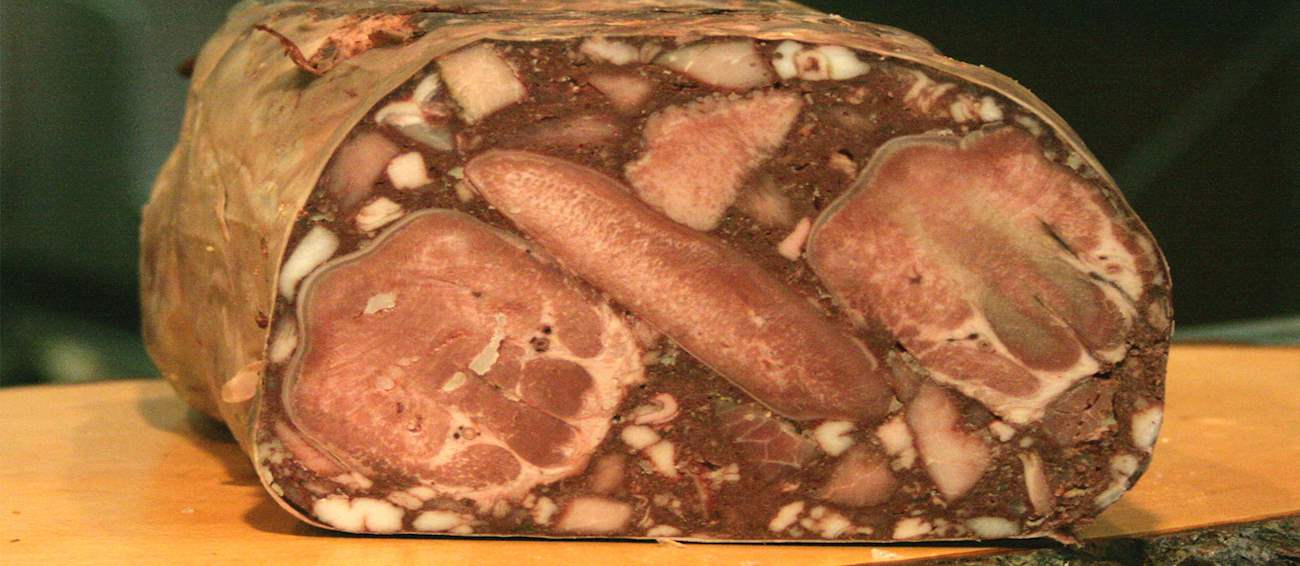Żymlok is a traditional Silesian blood sausage consisting of a mixture of pork blood, bread rolls, ground pork offal, onions, spices, and seasonings stuffed into intestines. The ground meat is cooked in meat broth and the bread rolls are soaked in the same broth before they are combined and added to the intestines.
Bread rolls are called żymła in Silesian and bułka in Polish, hence the name of this sausage. Żymlok is usually flavored with aromatic spices such as marjoram, nutmeg, black pepper, bay leaves, allspice, and juniper berries. Although it appears to be a regular sausage, its consistency is similar to black pudding.
Zungenwurst is a traditional blood sausage that contains pieces of pickled tongues. It typically consists of a mixture of pork blood, fat, and pieces of pickled tongues, seasoned with ground pepper and (optionally) other strong spices. Usually, the blood sausage is entirely made of animal parts, containing no fillers or cereals.
Since the sausage is typically cured and dried, it requires no cooking prior to its consumption. A common sausage in Austria as well, it can be consumed both hot and chilled, fried, or sliced in sandwiches. Its name is derived from the German words Zungen, meaning tongues in English, and Wurst, which translates to sausage.
MAIN INGREDIENTS
Belonging to the category of cooked sausages, blutwurst is a famous German blood sausage with many regional varieties. It is predominantly made with pork and incorporates animal blood, fat, and meat, next to a wide variety of seasonings such as marjoram, allspice, and thyme.
Blutwurst comes in various sizes, and many regional versions include barley, oats, or bread, while some varieties may even consist of diced bacon or innards. Since this blood sausage is typically cooked, it has a firm consistency and is commonly enjoyed as an appetizer alongside other cold cuts.
MOST ICONIC Blutwurst
View moreMAIN INGREDIENTS
Krvavice are blood sausages produced mostly throughout continental Croatia, especially in the regions of Zagorje, Istria, Dalmatia, and Slavonija-Baranja. Apart from Croatia, the sausages are also commonly consumed in Slovenia and Serbia. They're made by cooking pork blood, skin, and offal with rice and either buckwheat, barley, or cornflour, unlike most other European blood sausages that use oats or oatmeal as fillers.
However, there are numerous varieties of krvavice and every cook has his own recipe, so the ingredients may vary. The names also vary, and they're also called divenice, devenice, or kulenice. These sausages are traditionally consumed during winter when they are often accompanied by sauerkraut and a combination of boiled potatoes and sautéed onions known as restani krumpir.
VARIATIONS OF Krvavice
One of the staples of traditional Polish cuisine, krupnioki śląskie is a blood sausage made with smoked pork, pig's blood, and buckwheat, combined with salt, pepper, allspice, onions, garlic, and marjoram. The origins of this prized Silesian delicacy can be traced back to the late 18th century.
Once enjoyed only on special occasions, the krupnioki blood sausages are nowadays available throughout the year and found in every Polish delicatessen. They are traditionally served hot, accompanied by bread, mustard, pickled vegetables, and a glass of strong Polish beer.
Even though there are numerous regional varieties of this famous Polish blood sausage, it typically consists of pork offal, animal’s blood, barley or buckwheat, and a variety of spices and fresh herbs. Kaszanka was probably created under the influence of German and Danish culinary traditions and was primarily enjoyed by the noblemen.
The modern variety of kaszanka appeared later, and today, it is one of the most commonly consumed Polish sausages. Whether grilled, fried, or cooked, it is usually served alongside caramelized onions, potatoes, or sauerkraut.
MAIN INGREDIENTS
Jelito is a traditional blood sausage. Prepared with pig’s blood and ground pork meat (mainly head, belly, and offal) it incorporates lard and various spices such as marjoram and cumin. Many jelito variations also consist of grains or plain white buns, which provide a more compact consistency.
Since it is a non-smoked sausage, it is traditionally boiled or fried before it is served alongside pungent mustard, horseradish, and cabbage.
TasteAtlas food rankings are based on the ratings of the TasteAtlas audience, with a series of mechanisms that recognize real users and that ignore bot, nationalist or local patriotic ratings, and give additional value to the ratings of users that the system recognizes as knowledgeable. TasteAtlas Rankings should not be seen as the final global conclusion about food. Their purpose is to promote excellent local foods, instill pride in traditional dishes, and arouse curiosity about dishes you haven’t tried.




